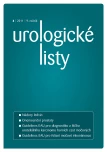COMBINATION THERAPY OF BENIGN PROSTATIC HYPERPLASIA – CLINICAL APLLICATIONS
Published in:
Urol List 2011; 9(4): 49-53
Overview
Benign prostatic hyperplasia (BPH) is the main cause of lower urinary tract symptoms in older men. Since introduction of α-adrenoreceptor antagonists (α-blockers) and 5α-reductase inhibitors, medical therapy has become the first-line treatment of BPH. Positive effect of either of the drug classes on relief of symptoms and clinical progression has led to combination therapy research, which, as proven by large clinical trials, is superior to monotherapy in terms of reducing the risk of acute urinary retention, BPH-related surgery and clinical progression in patients at risk. The article provides complex data on combination therapy with α-blockers and 5α-reductase inhibitors based on results of two long-term, randomized, double-blind trials: MTOPS (The Medical Therapy of Prostatic Symptoms) a CombAT (The Combination of Avodart® and Tamsulosin).
Key words:
benign prostatic hyperplasia, combination therapy
Sources
1. Berry SJ, Coffey DS, Walsh PC et al. The development of human benign prostatic hyperplasia with age. J Urol 1984; 132(3): 474–479.
2. Welch G, Weinger K, Barry MJ. Quality-of-life impact of lower urinary tract symptom severity: results from the Health Professionals Follow-up study. Urology 2002; 59(2): 245–250.
3. Roehrborn CG et al. Benign Prostatic Hyperplasia: Etiology, Pathophysiology, Epidemiology and Natural History. Campbell-Walsh Urology, 10th edition. Philadelphia: Saunders 2012 : 2570–610.
4. Oelke M, Bachmann A, Descazeaud A et al. Guidelines on the Treatment of Non-neurogenic Male LUTS. EAU Guidelines. Uroweb 2011. Available at: http://www.uroweb.org/gls/pdf/12_Male_LUTS.pdf. Accessed November 27, 2011.
5. Roehrborn CG. Pathology of Benign Prostatic Hyperplasia. Int J Impot Res 2008; 20: S11–18.
6. Emberton M, Andriole GL, de la Rosette J et al. Benign prostatic hyperplasia: a progressive disease of aging men. Urology 2003; 61(2): 267–273.
7. Abrams P, Chapple C, Khoury S et al. Evaluation and treatment of lower urinary tract symptoms in older men. J Urol 2009; 181(4): 1779–1787.
8. Kaplan SA. Update on the American Urological Association guidelines for the treatment of benign prostatic hyperplasia. Rev Urol 2006; 8(4): 10–17.
9. Michel MC, Vrydag W. α1-, α2 - and β-adrenoceptors in the urinary bladder, urethra and prostate. Br J Pharmacol 2006; 147 (Suppl 2): 88–119.
10. Barendrecht MM, Abrams P, Schumacher H et al. Do α1-adrenoceptor antagonists improve lower urinary tract symptoms by reducing bladder outlet resistance? Neurourol Urodyn 2008; 27(3): 226–230.
11. Michel MC, Mehlburger L, Bressel HU et al. Comparison of tamsulosin efficacy in subgroups of patients with lower urinary tract symptoms. Prostate Cancer Prost Dis 1998; 1(6): 332–335.
12. Rittmaster RS, Norman RW, Thomas LN et al. Evidence for atrophy and apoptosis in the prostates of men given finasteride. J Clin Endocrinol Metab 1996; 81(2): 814–819.
13. Naslund MJ, Miner M. A review of the clinical efficacy and safety of 5α-reductase inhibitors for the enlarged prostate. Clin Ther 2007; 29(1): 17–25.
14. Boyle P, Gould AL, Roehrborn CG. Prostate volume predicts outcome of treatment of benign prostatic hyperplasia with finasteride: meta-analysis of randomized clinical trials. Urology 1996; 48(3): 398–405.
15. Lepor H, Williford WO, Barry MJ et al. The efficacy of terazosin, finasteride, or both in benign prostatic hyperplasia. Veterans Affairs Cooperative Studies Benign Prostatic Hyperplasia Study Group. N Engl J Med 1996; 335(8): 533–539.
16. Kirby RS. A randomized, double-blind crossover study of tamsulosin and controlled-release doxazosin in patients with benign prostatic hyperplasia. BJU Int 2003; 91(1): 41–44.
17. McConnell JD, Roehrborn CG, Bautista O et al. The long-term effect of doxazosin, finasteride, and combination therapy on the clinical progression of benign prostatic hyperplasia. N Engl J Med 2003; 349(25): 2387–2398.
18. Roehrborn CG, Siami P, Barkin J et al. The effects of combination therapy with dutasteride and tamsulosin on clinical outcomes in men with symptomatic benign prostatic hyperplasia: 4-year results from the CombAT study. Eur Urol 2010; 57(1): 123–131.
19. Roehrborn CG, Siami P, Barkin J et al. The effects of dutasteride, tamsulosin and combination therapy on lower urinary tract symptoms in men with benign prostatic hyperplasia and prostatic enlargement: 2-year results from the ComAT study. J Urol 2008; 179(2): 616–621.
20. American Urological Association. Guideline on The Management of Benign Prostatic Hyperplasia (2010). Available at: http://www.auanet.org/content/ clinical-practice-guidelines/clinical-guidelines/main-reports/bph-management/chap_1_GuidelineManagementof%28BPH%29.pdf. Accessed November 30, 2011.
Labels
Paediatric urologist UrologyArticle was published in
Urological Journal

2011 Issue 4
Most read in this issue
- PROSTATE CANCER PREDICTION BASED ON PCA3 EVALUATION
- RENAL CANCER EARLY DETECTION, THE ROLE OF TUMOUR MARKERS IN FURTHER DIAGNOSTIC, THERAPEUTIC AND PROGNOSTIC STRATEGY
- SURGICAL MANAGEMENT OF THE RENAL CANCER WITH THE TUMOR THROMBUS IN THE VENOUS SYSTEM T3B AND T3C
- LAPAROSCOPIC AND ROBOTIC HEMINEPHRECTOMY AND URETEROURETEROSTOMY FOR DUPLEX COLLECTING SYSTEM OF UPPER URINARY TRACT
